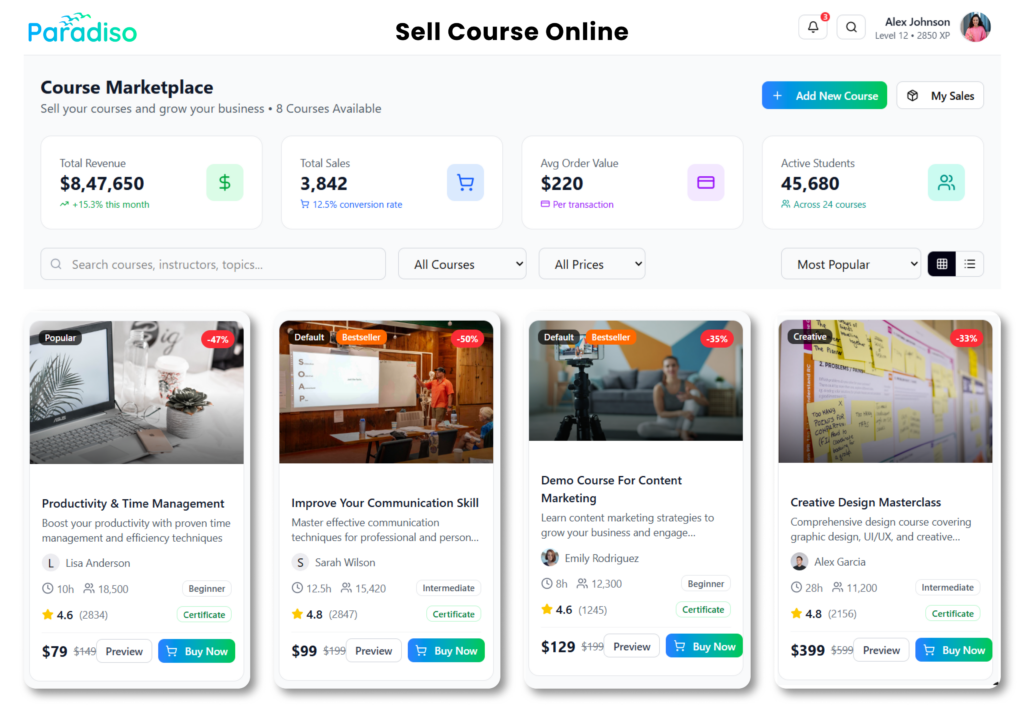Are you an expert in a particular subject and looking to share your knowledge while earning extra money? Selling online courses can be lucrative in today’s digital age. With the global e-learning market expected to reach $325 billion by 2025, there has never been a better time to create and sell online courses. However, with the abundance of online courses, standing out in a crowded market can take time and effort. In this article, we will provide you with a step-by-step guide, useful tips, and real-world examples of creating and selling online courses that will capture your audience’s attention and generate revenue. So, whether you’re a seasoned instructor or just starting, keep reading to learn how to turn your expertise into a profitable online course.
Why invest in selling online courses?
Why create and sell online courses?
In today’s digital era, e-learning has become an increasingly popular way for people to acquire new skills and knowledge. With the widespread availability of the Internet and the growing demand for remote learning, online courses have become a convenient and accessible way for people to learn at their own pace and on their schedule. As a result, creating and selling online courses has become an essential way for experts and educators to share their knowledge and skills with a global audience. With the ability to reach millions of students worldwide, online courses have the potential to transform education and make learning more accessible and inclusive. By creating and selling online courses, you can tap into this growing market and positively impact the world while earning a good income.
How to Sell Courses Online in 7 easy steps
- Choose a niche: Identify a specific area of expertise or skill you want to teach and select a niche audience interested in your course.
- Develop quality content: Create high-quality content for your course that is engaging, informative, and easy to understand. You can use multimedia tools such as videos, images, and interactive quizzes to make your course more engaging.
- Price your course: Determine a fair price based on the value it provides and the market demand. You can offer different pricing options, such as one-time payments, monthly subscriptions, or bundled packages.
- Choose an online platform: Select a reliable platform that offers course hosting, payment processing, and marketing tools to help promote and sell your course. Paradiso CourseCart is one such platform that offers a range of features to help you create, manage, and sell your online courses.
- Market your course: Use various marketing strategies such as social media, email marketing, and paid advertising to promote your course and attract potential students.
- Launch your course: Launch your course with a strong marketing campaign, and provide excellent customer service and support to your students.
- Analyze and optimize: Continuously monitor and analyze your course performance, gather student feedback, and make improvements to optimize your course and increase sales.
Choose a topic for your Online Course
Choosing the right topic for your online course is crucial to its success. The topic should be something you’re knowledgeable and passionate about and should also be in high demand among your target audience. Consider researching and identifying market gaps your course can fill. Consider your target audience and their pain points, challenges, and goals. This will help you tailor your course content to their needs and interests.
Research your course subject matter
Researching your course subject matter is essential in creating a high-quality and effective online course. Before creating content, you should conduct thorough research to ensure that your course provides your students with accurate, up-to-date, and valuable information. Review relevant literature, articles, and research papers related to your topic. You can also conduct interviews with experts in your field or consult with other professionals to gather insights and perspectives. It’s also important to consider your audience’s level of knowledge and experience in the subject matter and tailor your content to meet their needs. By conducting extensive research, you can ensure that your course content is informative, engaging, and relevant, providing your students with a valuable learning experience.
Outline your online course’s goals and objectives
Before creating content for your online course, it’s important to outline clear goals and objectives. Your goals should define what you want your students to achieve by the end of the course, while your objectives should outline specific, measurable steps to achieve those goals. This will help you create a structured and cohesive course that meets the needs of your target audience. When setting your goals and objectives, consider what skills, knowledge, or competencies you want your students to acquire and how you can help them achieve those outcomes. Your goals and objectives should be realistic, achievable, and relevant to your course content and target audience.
Create your online course
Creating an online course can be challenging, but with the right approach, you can develop high-quality content that engages and educates your target audience. Break down your course content into small, manageable modules or sections. This will make it easier to develop individual lessons and ensure that your course follows a logical and coherent structure. Next, consider incorporating multimedia elements such as videos, images, and interactive quizzes to make your course more engaging and interactive. It’s also important to ensure that your content is easy to understand and accessible to a wide range of learners, including those with varying levels of knowledge and experience. By creating high-quality content that is engaging, informative, and accessible, you can develop an online course that provides a valuable learning experience to your students while also establishing yourself as an expert in your field.
Price your online course
Pricing your online course can be tricky, and it’s essential to balance affordability for your target audience and profitability for your business. First, consider the amount of time and effort you’ve invested in creating the course and the value it provides to your students. Then, research the prices of similar courses in the market to determine a competitive price point. You can also offer discounts or promotions to attract new students or reward loyal customers. By pricing your online course appropriately, you can maximize your earnings while still providing a valuable learning experience to your students.
Market and sell your online course
Marketing and selling your online course is crucial to its success. You can use social media promotions, email campaigns, and paid advertising to reach potential students and increase visibility. Leverage existing networks or partnerships to promote your course and reach a wider audience. Monitor and optimize your marketing efforts to ensure they reach the right audience effectively. CourseCart is an all-in-one platform for creating and selling online courses, simplifying course management, payment processing, and storefront customization, allowing you to focus on creating high-quality content.
Launch and refine your online course
Once you’ve created your online course, Paradiso CourseCart can help you launch and refine it. You can use the platform’s built-in tools to track student progress, gather feedback, and improve the course over time. You can also use CourseCart’s reporting and analytics features to gain insights into student engagement and performance, allowing you to make data-driven decisions about optimizing the course content.
CourseCart offers support services to help you troubleshoot any technical issues and ensure your students have a seamless learning experience. With Paradiso CourseCart, you can create, launch, and refine your online course to provide a valuable learning experience for your students while maximizing your revenue potential.














